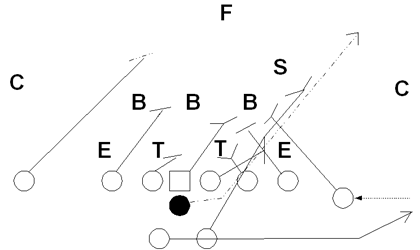
Well, first, let me rename this play as the "former" Nebraska G Option. The new and "improved" Nebraska wouldn't think of running such a "rudimentary" play, I'm sure. Well, the new and improved Nebraska lost to an unranked team this week... I bet by the end of this season good ol' 9-2 Solitch will start lookin' good to the Nebraska faithful. ...Fire a coach after a 9-2 season. They oughtta lose. Just make sure you send moving vans to the genius A.D. that started all this mess, too, Nebraska fans. Don't forget him!
Well, enough of that. Here is the (former) Nebraska G-Option Eric Couch ran so well. It really isn't an option. It's a QB keeper with the initial look of an option... makes the D account for the option.... notice how the pitch back will suck the CB out of the play in order to contain the pitch which isn't coming. I got this play from the Neb - Colorado game a few years back. Neb ran it from the "I" but it should work just as well from splitbacks. Anyway, its uses wing T "G" or "Down" blocking... which I like since it gives me angle blocking at the point of attack. The Z motions in or aligns tighter (a wing, perhaps?) so he can seal inside.
Coach Smith
Below is the play diagram versus a balanced 52 "Cloud" defense.

6 comments:
Reguarding the Nebraska G Play:
How would you block it against a True 5-2 defense with 4 technique tackles in the double Tight End Set? Or is there a better formation for it?
Thanks,
Welcome to Veersite!
Versus heads-up 4 techniques in a balanced 5-2, the psTE and psT would still take thier paths to thier intended blocks. Our rule (and everyone else's, I expect) is neve let anybody cross your face to the inside. If the 4 tech DT pinches, for example, the psT will pick him up on his path to psILB. The psTE will not have the 4 tech to block and will continue on his path- realizing that the psILB will be his man now. The psG is pulling out to kick the psDE. If the DE is gone he will turn upfield looking for somebody to block second level. This is the same rule he has when he's pulling across the formation, BTW, so where is minimal reteaching. The center better be zone stepping playside and playing on the knees since he is one-on-one with the noseguard... the backside G can scoop the nose if all goes well, leaving the Center to continue upfield to get the backside ILB.
All the path-blocking comes from when I was Crockett County High School... we were trying to install the Wing-T and the actual play was the FB "G" play.
I hope this makes sense... let me know what you think.
Coach Smith
I'll go ahead and diagram this up vs. the 5-2 and post is today. I took the day off to catch up on some chores around the house and it won't take much time.
Coach Smith
Thanks for the help. We run the Split Back veer out of predominantly the Flanker set and the 5-2 defense is really giving us fits. We run a lot of OV and IV against this look along with a dive option very similar to IV with no dive read and we also run a lead option. I noticed your diagram of the lead option is a little different than the way we run it. We run ours like this: The Lead back is to take a flat plan (parallel to the line of scrimmage) to the perimeter and block the force player. The TE has two possibilities. If the tackle is covered, we run a quick combo with him to the backer. If the tackle is uncovered the TE arcs to the backer. This play used to be very productive for us, but teams are now slowing playing their DEs and we are not as successfull. We have tried to go to more of a Dive Option off our IV look to hold things tighter but we are still struggling to get to the perimeter. Any thoughts? Thanks again for the "G" diagram
Hmmm... I'm not sure why you're not getting to the perimeter. We have about 3 things that screw us the hell up in that regard.
1. HB's too deep. The heels of our HB's are 4 yards from the nose of the football. Too deep means too slow in our OSV.
2. psDT penetrating into the backfield. If the QB has to "jump the hump," it slows things down and gives the defense better angles.
3. fast ILBs running you down inside -out. could be several things depending on the play. We slow ours down with snap count, inside trap away fro the veer action, play action of some sort behind the LBs.,
etc.
Depending on the secondary coverage, you might be able to hit your wideouts on hitches and stop routes... the TE on a shoot or bench route in the flats. If your can't run wide, then throw wide. Its hard to
think about in general w/o seeing the problem.
well gotta hit the sack, will check email tomorrow night.
Stephen T. Smith
steve@stsmith.com
Post a Comment